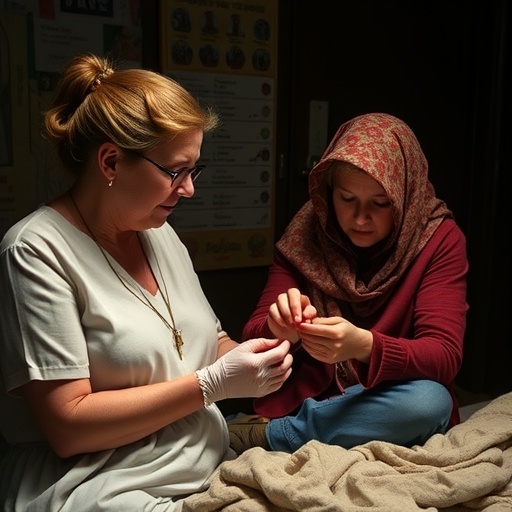In a groundbreaking study that promises to reshape our understanding of addiction’s lasting effects on the brain, researchers have uncovered a striking dissociation between self-related and mother-related cognitive processing in individuals recovering from heroin misuse. Published in the journal Translational Psychiatry, this research sheds new light on the complex neural dynamics underpinning addiction and abstinence, revealing how intimate social bonds and self-awareness pathways are altered long after drug use ceases.
Heroin addiction is notoriously difficult to overcome, with relapse rates remaining high despite advances in treatment programs. While much of addiction research focuses on cravings and behavioral triggers, this new study delves into the subtler, yet profound, transformations occurring in the brain’s social and self-referential cognition networks. The researchers specifically examined brain activity patterns related to processing stimuli connected to the self versus those connected to a primary attachment figure—the mother—in abstinent heroin users, revealing an intriguing neural dissociation.
Using functional magnetic resonance imaging (fMRI), the team mapped the brain responses of individuals who had maintained abstinence from heroin for a significant period. Participants were presented with words and images related either to themselves or their mothers, allowing researchers to observe the differential activation of brain regions implicated in self-referential thinking and attachment. This precise neuroimaging method provides an unparalleled window into how the brain organizes personal identity and social bonds after chronic drug exposure.
Remarkably, the data illustrated that, in abstinent heroin misusers, self-related processing engaged neural circuits distinctly from those activated during mother-related processing. This dissociation was evident in regions of the default mode network, which include the medial prefrontal cortex, posterior cingulate cortex, and temporoparietal junction—areas crucial for constructing the narrative self and empathic understanding. Such segregation hints at a fragmented social cognitive framework that may persist well beyond the cessation of drug use.
The study’s insights are especially pertinent considering the importance of familial support and self-concept in the recovery trajectories of addiction. Prior models have often treated these domains as overlapping or mutually reinforcing. Yet, the observed neural divergence suggests that abstinent heroin users may experience a kind of cognitive compartmentalization: their sense of self may not harmoniously integrate with their attachment representations, potentially complicating emotional regulation and interpersonal relationships essential for sustained recovery.
On a mechanistic level, these findings align with theories proposing that chronic heroin use disrupts the brain’s reward and social cognition circuits differently. The dopaminergic system, centrally implicated in addiction, modulates how rewarding stimuli—including social stimuli—are processed. The differential brain activation patterns might reflect long-term adaptations or maladaptations within this system, affecting how abstinent users relate internally and socially.
Importantly, the research does not merely demonstrate altered neural patterns but also correlates these changes with behavioral and psychological assessments. Abstinent heroin users exhibiting greater dissociation in self- and mother-related processing also showed signs of impaired emotional awareness and difficulty in social interactions. These clinical observations underscore the functional impact of the neural dissociation and point to novel targets for therapeutic intervention.
The study’s methodological rigor adds weight to its contributions. By controlling for factors such as duration of abstinence, comorbid psychiatric conditions, and cognitive capacity, the researchers ensured that the observed neural patterns were specifically attributable to the history of heroin misuse, rather than confounding variables. This robust approach enhances the reliability and translational potential of the findings.
These discoveries open vibrant avenues for future research. For example, longitudinal studies could investigate whether this dissociation diminishes over extended periods of abstinence or whether specific psychosocial interventions might help reintegrate self and mother-related processing networks. Neurofeedback, cognitive behavioral therapy, and even pharmacological strategies aimed at restoring neural synchrony in social cognition circuits could be explored.
Moreover, the implications reach beyond heroin misuse alone. Other substance use disorders, and even behavioral addictions, might display similar dissociations in self-other processing. Understanding these neural signatures could refine diagnostic models and personalize treatment approaches, emphasizing the restoration of healthy social cognitive functioning as a pillar of recovery.
The research also invites a reevaluation of the role of primary attachment figures in addiction treatment. While familial involvement is often advocated, this study suggests that the subjective cognitive representation of these relationships may differ markedly in those recovering from heroin addiction. Clinicians may need to address this gap through targeted psychosocial support designed to reforge these disrupted neural and emotional connections.
In a broader context, the study exemplifies the power of combining advanced neuroimaging with nuanced psychological constructs to unpack the complex, multidimensional nature of addiction. It moves the conversation beyond simple cause-and-effect models toward an integrated framework capturing how identity, attachment, and brain function intertwine in health and disease.
Ultimately, this research shines a light on the hidden cognitive and neural struggles faced by abstinent heroin users—challenges that extend far beyond the surface symptoms of craving and withdrawal. By revealing the neural dissociation between the self and a fundamental social bond, it challenges researchers and clinicians alike to rethink recovery as not merely the absence of drug use, but the restoration of fragmented domains of the self.
As we confront the global opioid crisis, these insights underscore the urgent need to develop holistic treatment strategies that incorporate brain-based understanding of social cognition. Empowering individuals to rebuild coherent self-identity and nurture healthy relationships may be as critical as controlling biochemical dependencies in achieving lasting recovery.
This landmark study represents a promising step in that direction, highlighting the intricate dance between brain, mind, and social ties following heroin addiction. It compels the scientific community to advance beyond symptom management and toward healing the fractured cognitive landscapes left in addiction’s wake—offering renewed hope for countless individuals striving to reclaim their lives.
Subject of Research: Neural processing of self- and mother-related stimuli in abstinent heroin users
Article Title: Dissociation of self and mother-related processing in abstinent heroin misusers
Article References:
Liang, Q., Zhang, Y., Wang, Y. et al. Dissociation of self and mother-related processing in abstinent heroin misusers. Transl Psychiatry 15, 372 (2025). https://doi.org/10.1038/s41398-025-03594-y
Image Credits: AI Generated




